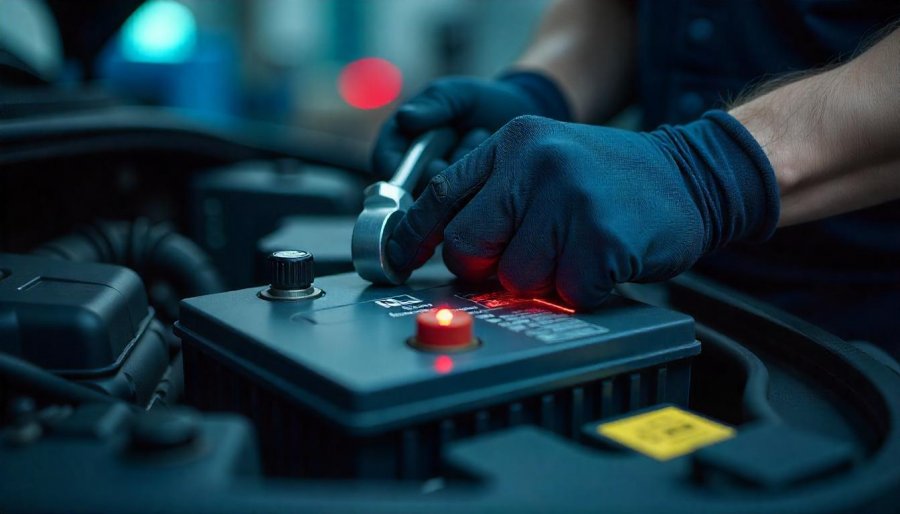Imagine a routine check that can save you from unexpected breakdowns and keep your vehicle dependable under all conditions. How often do you think about your car’s battery until it fails? This guide reveals the secrets to mastering battery maintenance—simple yet vital steps like cleaning corrosion, inspecting for damage, and ensuring tight connections. But it goes beyond basics: seasonal tips for weather challenges, environmental considerations, and smart habits like disconnecting the battery during long stops or using trickle chargers. When you understand how to nurture your battery, you unlock worry-free driving, fewer stressors, and a vehicle that starts reliably every time. Are you ready to prevent costly repairs and roadside emergencies by adopting these easy, proactive strategies? Your vehicle’s heart—its battery—deserves attention, and with a few mindful practices, you can extend its life and enjoy seamless journeys all year round.

Keep Your Car Reliable: Essential Battery Care Tips
Your vehicle’s battery might not get much attention until it suddenly fails, leaving you stranded and frustrated. Yet, a little routine care can make all the difference in keeping your car dependable and ready to go whenever you need it. Think of your battery as the heart of your car’s electrical system—without it, the engine won’t start, and the gadgets you rely on, like headlights, the radio, and climate controls, won’t work either. Maintaining it isn’t just about convenience; it’s a key step in preventing those unexpected breakdowns that can disrupt your day or leave you stuck somewhere inconvenient.
A healthy battery is essential for smooth, reliable driving. Cold mornings and long trips place extra demands on your vehicle’s power source, making regular maintenance even more important. When your battery is in good shape, you’re less likely to face issues when rushing to work or heading out for a weekend getaway. Spending a few minutes on simple checks now can save you time, money, and stress later. It’s a small effort that ensures your vehicle starts reliably every time you turn the key, giving you peace of mind on the road.
Many drivers overlook the importance of routine battery checks because they seem minor or straightforward. However, quick inspections—like looking for corrosion, ensuring connections are tight, and checking for signs of damage—are simple tasks that can flag potential issues early. Catching early warning signs such as sluggish engine cranking, dimming lights, or erratic electronics allows you to address problems before they escalate into costly repairs or roadside emergencies. Incorporating these simple steps into your regular maintenance routine keeps your vehicle running smoothly and helps you avoid unexpected breakdowns.
Understanding the environment your vehicle operates in also plays a crucial role in battery care. Extreme weather conditions—whether scorching heat or freezing cold—can accelerate battery wear and reduce its lifespan. Hot summers cause the fluids inside the battery to evaporate faster, risking internal damage, while cold winters make starting your vehicle more difficult and put extra strain on the battery’s capacity. Being aware of these seasonal challenges and adjusting your maintenance routine accordingly can help your battery withstand harsh conditions, ensuring reliable starts regardless of the weather.
In essence, caring for your vehicle’s battery isn’t complicated, but it’s an essential part of responsible car ownership. Regular checks and simple maintenance tasks—like cleaning terminals, inspecting for damage, and ensuring tight connections—can extend the life of your battery and prevent inconvenient breakdowns. When you stay proactive, you’re not just avoiding surprises; you’re also supporting your vehicle’s overall reliability. A well-maintained battery means fewer worries on the road and more confidence that your car will start when you need it most.

Simple yet Effective Techniques to Maintain Your Battery’s Health
Maintaining your car’s battery is simpler than many think, but consistency is key. The first and most straightforward step is to inspect the battery terminals for corrosion. Look for a whitish, greenish, or bluish buildup around the posts—these deposits act like a barrier, hindering the flow of electricity. Cleaning them is quick and easy: mix a small amount of baking soda with water, apply it with an old toothbrush, and then rinse thoroughly. Once the corrosion is gone, dry the terminals completely and tighten the connections to ensure a solid electrical contact. Clean, tight terminals are vital for reliable starts and smooth electrical performance, especially if your vehicle has been sluggish or slow to turn over.
Beyond cleaning, examining the overall condition of your battery’s surface is essential. Check for any cracks, leaks, or bulging on the casing, which can indicate internal damage. If you notice any of these signs, it’s wise to have the battery tested or replaced before it leaves you stranded. Some batteries allow for checking the electrolyte levels—if your vehicle has removable caps, open them carefully and top up with distilled water if needed. Proper fluid levels keep the internal plates covered and functioning optimally, helping extend the battery’s lifespan. Handle the electrolyte with care, as it’s a corrosive substance that can cause burns if mishandled.
Securing your battery properly is another crucial aspect of maintenance. Vibrations from rough roads or frequent stops can loosen clamps and connections over time. Regularly inspect that the battery is firmly mounted and that the terminals are tight. Loose connections can cause flickering headlights, erratic gauges, or difficulty starting the engine. When tightening, do so gently—over-tightening risks damaging the posts or casing. Taking a few moments to confirm everything is secure prevents many common electrical issues and ensures your vehicle runs reliably without hiccups.
Maintaining a clean environment around your battery is often overlooked but plays a significant role in its longevity. Dirt, leaves, and grime can trap moisture, which accelerates corrosion around the terminals and casing. Wiping down the battery and the surrounding area with a damp cloth removes debris and helps keep the battery cooler. A cleaner environment reduces the risk of corrosion and overheating, both of which can impair performance, especially during extreme weather. If you notice any buildup or leaks, addressing these early prevents more serious problems later on, saving you time and money.
Monitoring your vehicle’s electrical load is an often-neglected but vital part of battery care. Avoid leaving headlights, interior lights, or other electronics on when the engine isn’t running, as they drain the battery. If your vehicle sits unused for extended periods, consider disconnecting the negative terminal or using a maintenance charger—also known as a trickle charger. These devices keep your battery topped off without overcharging, which is especially helpful in hot summers or cold winters when batteries tend to lose charge more quickly. Regularly managing your electrical load helps preserve your battery’s health and ensures it’s ready to start whenever you need it.
Finally, don’t ignore the subtle signs that your battery might be nearing the end of its life. Slow engine cranking, dimming headlights, or electronic malfunctions are often early clues. A faint sulfur smell near the battery or unusual dashboard warnings also indicate potential issues. Catching these signals early allows you to replace the battery before it fails completely, preventing roadside breakdowns and costly repairs. Staying attentive to your battery’s condition, combined with routine checks and simple maintenance, keeps your vehicle dependable and your driving worry-free.

Unlock Hidden Secrets to Maximize Battery Life and Ensure Dependable Performance
Going beyond the basics of terminal cleaning and fluid checks, there are several lesser-known strategies that can significantly boost your battery’s lifespan and reliability. One simple but often overlooked tip is to pay attention to where you park your vehicle. Choosing shaded or covered spots instead of direct sunlight helps prevent internal fluid evaporation and keeps the battery cooler. Excessive heat accelerates chemical reactions inside the battery, leading to faster wear and potential internal damage. Keeping your vehicle in a shaded area during hot weather can make a real difference in preserving battery health over time.
Another effective approach involves maintaining your vehicle’s entire electrical system. A healthy alternator, starter, and charging circuit reduce unnecessary stress on the battery. If your dashboard flickers or gauges act erratically, it might be a sign that your electrical system needs attention. Addressing these issues early prevents the battery from overworking, especially during long drives or when operating multiple electronic devices. Regular electrical system checks can uncover hidden problems before they cause a roadside breakdown, saving you both time and money.
Some drivers swear by a simple trick: disconnecting the battery if their vehicle will sit unused for an extended period. This can help prevent parasitic drain—small electrical loads that slowly deplete the battery when the car is off. By disconnecting the negative terminal, you reduce internal power drain and keep the battery fully charged for when you need it again. Just remember to turn off all electronics before doing this and follow safety precautions. This small step can extend your battery’s life significantly, especially during long periods of inactivity.
Investing in a battery maintainer or trickle charger is another smart move, particularly if your car isn’t driven daily. These devices keep your battery topped off without risking overcharging, which can damage internal plates. During extreme weather—hot summers or freezing winters—batteries tend to lose charge faster. Hooking up a maintainer during these times ensures your battery remains in good shape, ready to start your vehicle when needed. It’s a simple, cost-effective way to extend your battery’s longevity and avoid unexpected failures.
Drive habits also impact battery health more than many realize. Short trips with frequent stops don’t give your alternator enough time to fully recharge the battery, leading to a slow decline in performance over time. If your driving mostly involves city errands, occasionally taking longer drives can help the battery recover and maintain its capacity. Maintaining a steady electrical load during extended drives helps internal components stay in good condition, which supports overall vehicle reliability. This small adjustment in your routine can prevent early battery wear and keep your car dependable.
Finally, staying alert to early warning signs can save you from sudden breakdowns. Beyond sluggish engine starts, pay attention to dimming headlights, electronic glitches, or a faint sulfur smell near the battery—these are often precursors to failure. Addressing these signals promptly by testing or replacing the battery can keep you ahead of trouble. Regularly inspecting your battery’s condition and taking proactive steps ensures that your vehicle remains reliable, no matter the season. These lesser-known tips, combined with routine care, form a comprehensive approach to maintaining a healthy, dependable battery, letting you enjoy worry-free driving all year round.
For additional guidance on maintaining your vehicle’s electrical system and ensuring your battery stays in top condition, consider exploring helpful resources such as this comprehensive guide on vehicle battery maintenance. Learning more about proper care can help you implement these strategies effectively and prolong your battery’s lifespan.






